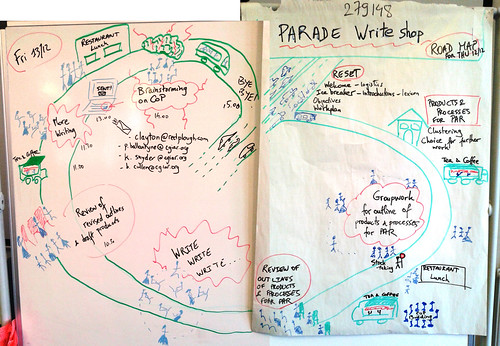Participatory action research can add value to CGIAR’s agronomic research
This post was drafted by Terry Clayton based on contributions by Katherine Snyder (CIAT) at the Participatory Agricultural Research: Approaches, Design and Evaluation (PARADE) workshop held in Oxford from 9-13 December 2013.
Agricultural research is still seen primarily as research in plant, animal and soil science that affects crop production. The social, economic, and political bases of crop production and land management have most often taken a back seat to the design of technical interventions. Participatory research is still seen as an ‘add on’ after the ‘real’ research has been completed. Farming systems research and Robert Chambers’ work on ‘putting farmers first’ created an impact, but participatory approaches are still marginal within agronomic research. How do we change that?
New opportunities
The most recent CGIAR reform process offers new opportunities to advance the cause of participatory agricultural research (PAR). Sustaining any advances will depend on designing new models of partnership and collaboration that emerged from the CGIAR Challenge Programs. In relation to partnerships with private sector, practitioners must be conscious that such alliances can have their implications on what gets researched and how results are disseminated, for example, who owns intellectual property rights and how research results are disseminated).
Paul Sillitoe touched on this point in his opening keynote when he said, “There is a danger of promoting the commercialisation of others’ knowledge, given development’s focus on promoting economic efficiency through various market interventions.” One of the central issues that reform is meant to address is countering the trend in donor funding that leads to short-term versus long-term research. PAR has an important role to play in convincing international donors that global development challenges cannot be resolved in 3-5 years.
Fundamental divisions in agronomic research
There are serious epistemological divides over what is ‘knowledge’ and what is ‘science’. This is reflected in ongoing debates over who frames a research problem and how it is carried out and how the results are presented. While a narrative for collaborative and interdisciplinary research is prominent, practice is often very different, with a focus on product rather than process results. One the main challenges facing PAR practitioners is how to move from perception of PAR as threat to PAR as a necessary complement to ‘hard’ science research.
Reflections

Why is participatory research not yet more central to agronomic research within the CGIAR system and elsewhere? The answer lies in developing a clearer research agenda on what PAR is and what it can achieve. Active practitioners see PAR as a means of identifying problems, risks and possibilities for improved livelihoods that add considerable value to the very necessary research on plant, animal and soil science, and must redouble their efforts to communicate this to the wider research community. Beth Cullen outlined the main challenges in her presentation, and as a result of the workshop, teams of participants are now drafting papers and action plans to address these issues. These include:
- A framework for integrated demand driven systems research (strategy paper and action plan)
- A community of practice Taskforce with a community of practice in each region actively monitored along with a community of practice annual meeting and use of social media.
- A training module on PAR that will include state of the art methods, R4D processes, management approaches, and ethics.
- A plan for communications and outreach focusing on how PAR contributes to achieving System Level Outcomes.
- An M&E checklist for monitoring and evaluating indicators, including common M&E frameworks and good practices and accountability mechanisms for PAR.
- A ‘state of the art’ review on how participatory agricultural research has been successful and how PAR contributes to the CGIAR System Level Outcomes.
Drafts of these products are posted on the PARADE Wiki.
More information
The PARADE expert meeting and writeshop aimed to identify more systematic ways of using methods and tools for Participatory Agricultural Research (PAR) to ensure that future research is more effectively targeted on development outcomes. The meeting was led by Katherine Snyder (CIAT) and Beth Cullen (ILRI) with support from Alan Duncan (ILRI), Peter Thorne (ILRI) and Peter Ballantyne (ILRI). It was funded by the CGIAR Research Program on Humid Tropics and Africa RISING.




